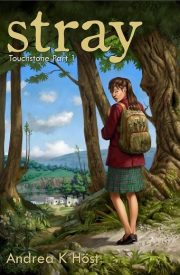The Empty Cities of Muina
Stray (Touchstone, volume 1)
By Andrea K. Höst

12 May, 2016
0 comments
For the life of me, I cannot remember how Andrea K. Höst’s 2011 Stray, the first volume in her Touchstone trilogy, got into my to-read queue, but I am happy that it did.
Cassandra Devlin’s plans involve high school graduation and one last party with her friends. They do not include somehow stepping from her native Australia to an unfamiliar alien world. Guess which option she gets?

Surviving on what Cassandra suspects might be an alien world using only the contents of her school backpack isn’t exactly fun. The world in which Cassandra finds herself clearly used to have natives — human or otherwise — but now all the Australian can find are long abandoned relics of a vanished civilization. As far as she can tell, nothing on the planet particularly wants to eat her, but something got rid of all the missing people.
With nobody but wild animals to supply a conversation, it does not seem likely that Cassandra will ever get answers to her many questions. It’s a hopeful moment, then, when she wakes to find two human-like strangers standing over her. They provide Cassandra with a lift to a more advanced planet. The one drawback is that she and her rescuers don’t share a common language. Answers will have to wait.
Once she can talk to her rescuers, Cassandra isn’t going to like the answers she gets.
~oOo~
Interesting: it was not so long ago that I was seeing arguments that the portal fantasy was completely dead. This is counterproof of that claim.
I was a bit perplexed that Muina, the alien world to which Cassandra was first transported, was populated by animals that appear to be close relatives of terrestrial species. After a moment’s thought, I decided that the alien world must have been settled from Earth. Nothing in this book would contradict that theory. In fact, once communication is established, Cassandra explains to her rescuers why their belief that humans originated on Muina is silly:
I find it hard to believe that the people from Earth are from some other planet. For one thing, you’d think we’d have legends or stories about Ionoth and this Ena place and Muina. And though they talked about this happening thousands of years ago, ‘modern’ humans have been on Earth for at least tens of thousands. So, not convinced, though since Tare people look just like Earth people there’s probably some connection.
In fact, humans branch from a lineage that demonstrably goes back hundreds of millions of years on Earth — as do the birds and mammals she sees on Muina. However, we can explain this by assuming that the portal that took Cassandra to Muina has existed for millions of years, so that migration from one world to another is possible.
Once Cassandra is rescued, this stops being a wilderness survival story á la Tunnel in the Sky and segues into superhero mode. There is a reason nobody lives on Muina: monsters from beyond space and time! And it’s the job of brave volunteers with special powers to hold those monsters at bay. The book is no longer about personal survival, but responsibility and teamwork: what is Cassandra willing to risk, to sacrifice, to keep her rescuers and their families safe?
As often happens in portal stories like this one, Cassandra turns out to have unique abilities that aid the common defence. However, what she offers is atypically passive for a protagonist in an adventure story. While I assume that this is completely unintentional, she is somewhat like Rod from Tunnel in that both of them make the people around them better. Of course, Rod does it by being so astoundingly thick that everyone else looks like a genius, whereas Cassandra turns out to amplify psychic powers. In each case, they contribute by being solid team players.
Höst also explores issues relating to civil liberties (starting with a snipe by Cassandra at her own government’s refugee policies). Cassandra’s hosts are technically advanced and in many ways are decent people, At the same time, they use nanotechnology to create an intrusive nanny state. Our governments may spy on us incessantly but at least they cannot reach into our brains and turn off language features they deem currently unsuitable.
This is the first book in a trilogy. Unsurprisingly, it raises more questions than it answers. I am left with the impression that there are answers, so I will be hunting down the rest of the books to see what those answers are.
Stray is available on Smashwords and as certain bold entrepreneurs say, the first hit is free.….
